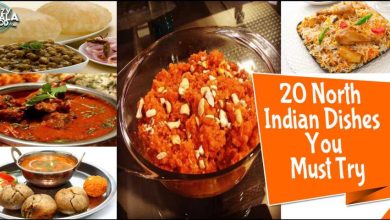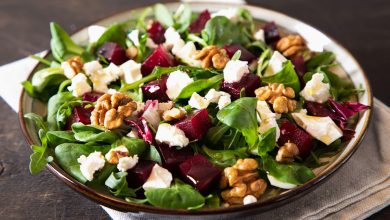Vegetables, Russian cuisine
Below are recipes for vegetable dishes from the cuisines of different countries. In addition, they are all Lenten, which means they are also suitable for those who observe Great Lent. As well as recipes from our selection of Main vegetable dishes from different countries: note for those who are fasting.
Russia: vinaigrette
Vinaigrette is a vegetable salad that has been known to everyone since childhood. It is simple, like everything ingenious, and universal, like everything simple. It is eaten on its own, because it is hearty and tasty, and is added as a vegetable supplement to meat.
Ukraine: Lenten borscht
This is an old Ukrainian dish, without which not a single post passed. The main difficulty in cooking is to guess the laying of products in borscht so that by the end of cooking they are not raw or boiled. To make beets and cabbage crunchy, the potatoes were soft, and the beans had a whole shell, but inside it was tender and creamy in taste.
Previously, lean borscht was cooked in the oven, where the products “kept up” for a long time without being boiled. Today they use a little trick: the beans soaked the night before are cooked separately in a small amount of water and added to the borscht at the end of cooking along with the broth.
At this time, 4-5 tablespoons of vegetable oil are heated in a deep frying pan, finely chopped onion is added, sautéed for 5 minutes, until golden brown. Then, carrots and beets, celery root or parsley, chopped into strips, are thrown into the pan and continue to fry for another 5-10 minutes.

At the end, chopped sweet peppers are added (canned lechon can be used) and 3-4 chopped tomatoes without peel (2-3 tablespoons of tomato paste can be used) with a teaspoon of sugar.
The finished frying is sent to the pan along with chopped cabbage, a couple of chopped garlic cloves, a teaspoon of paprika, bay leaf and beans prepared in advance along with a decoction. The dish boils over low heat for another 5 minutes, then add a handful of chopped herbs, turn off the heat and let the borscht brew under the lid for 10-15 minutes. Served both hot and cold with black bread and green onions.
Poland: cabbage soup with millet
Polish cuisine is rich in recipes for soups, as well as dishes made from millet, which in this country has always been called the “gold of the Polish land”. Kapustnyak – a lean soup with sauerkraut and millet – is an old peasant dish that was prepared in winter and spring. Sometimes dried mushrooms were added to it – for flavor and satiety. It is also prepared from fresh cabbage, adding tomato for acid. Recently, nutritionists have adopted this recipe: it is believed that eating cabbage daily can improve digestion, improve the quality of nails and hair, and lose weight.
Millet and sauerkraut soup is prepared very simply: half a glass of millet is washed several times with hot water until the drained water is no longer cloudy. Groats are added to boiling salted water (1.5 l) and cooked over low heat for 15 minutes. Meanwhile, heat a frying pan with 3 tbsp.
Sauerkraut (about 300 g) is squeezed and finely chopped. At the end of cooking, add half a teaspoon of paprika, a pinch of ground black pepper, bay leaf and a handful of finely chopped dill to the pan. Despite its simplicity, the soup is very tasty and easy to digest.
Russian cuisine has always been distinguished by a rich selection of vegetable dishes. People tried to use the land as efficiently as possible in order to get a varied crop and make harvests. After all, there was a long Russian winter ahead.

Weather conditions largely determined the range of cultivated crops: these were fast-growing vegetables, root crops, unpretentious fruits, and berries. Peasants planted things that retained their properties for a long time: onions, carrots, radishes, turnips, beets, garlic. The cabbage was also popular for cultivation. It grew quickly and did not require much attention when growing. The most favorite variety of cabbage in Russia is white cabbage.
In the 18th century, potatoes were brought from Europe. He won people’s love, displacing turnips, and became one of the most common agricultural crops in Russia. There was a period when potatoes were called the second bread. A century later, tomatoes were introduced. It took them longer to become popular in Russian cuisine. But when people realized that they change the taste of familiar food, give a spicy touch, they began to be added to many dishes.
Vegetables were added to soups, snacks, fillings, stewed, boiled, steamed, used in meat dishes and salads. Both fruits and boiled vegetables were added to salads. This is how vinaigrette appeared – a popular salad in the cold season.
Names of Russian vegetable dishes:
Cabbage – cabbage soup (more than 60 types), pies with cabbage, sauerkraut, stewed cabbage, borscht, cabbage pie.
Potatoes – rustic fried potatoes, shanezhki, karmic with potatoes and mushrooms, potato pie.
Beets – borscht, beetroot, vinaigrette.
This is not the whole list of vegetable dishes that Russian cuisine is rich in. Many traditional Russian recipes provide for the replacement of ingredients, so pies could be stuffed with fish, mushrooms, potatoes, or cabbage. Dishes in which several types of vegetables were mixed were popular.
The popularity of vegetable cuisine was also due to religious considerations. In Orthodox culture, people fasted a lot, so meat dishes were eaten less frequently. The hostesses compensated for the lack of meat with various masterpieces based on vegetables, mushrooms, and spices.



